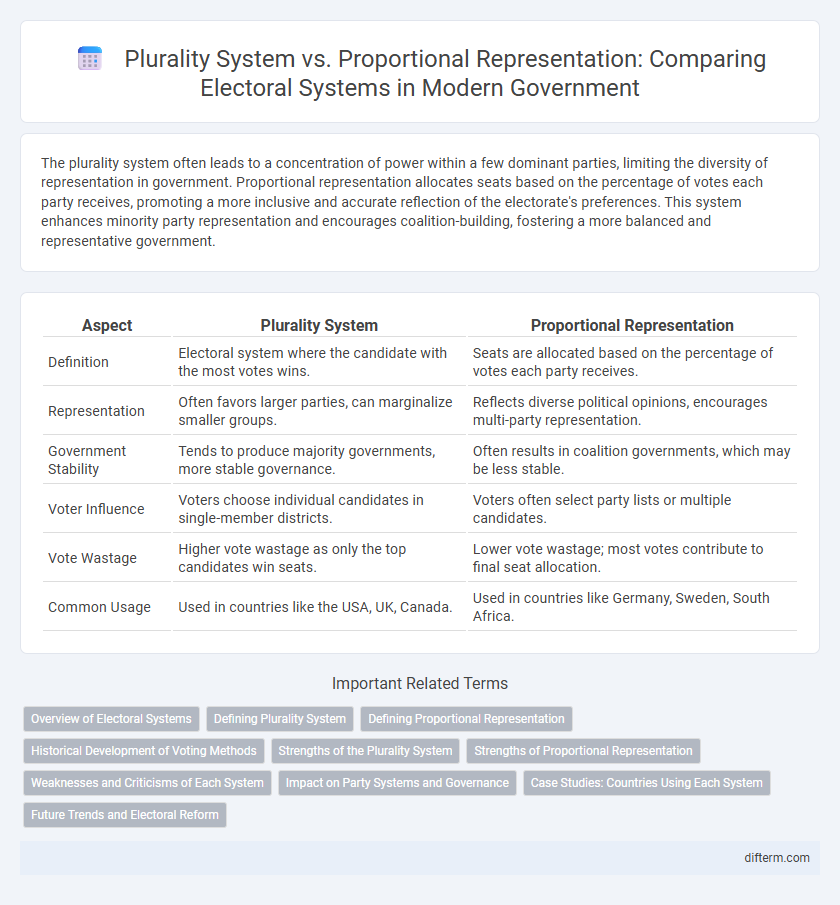The plurality system often leads to a concentration of power within a few dominant parties, limiting the diversity of representation in government. Proportional representation allocates seats based on the percentage of votes each party receives, promoting a more inclusive and accurate reflection of the electorate's preferences. This system enhances minority party representation and encourages coalition-building, fostering a more balanced and representative government.
Table of Comparison
| Aspect | Plurality System | Proportional Representation |
|---|---|---|
| Definition | Electoral system where the candidate with the most votes wins. | Seats are allocated based on the percentage of votes each party receives. |
| Representation | Often favors larger parties, can marginalize smaller groups. | Reflects diverse political opinions, encourages multi-party representation. |
| Government Stability | Tends to produce majority governments, more stable governance. | Often results in coalition governments, which may be less stable. |
| Voter Influence | Voters choose individual candidates in single-member districts. | Voters often select party lists or multiple candidates. |
| Vote Wastage | Higher vote wastage as only the top candidates win seats. | Lower vote wastage; most votes contribute to final seat allocation. |
| Common Usage | Used in countries like the USA, UK, Canada. | Used in countries like Germany, Sweden, South Africa. |
Overview of Electoral Systems
Plurality systems, often called 'first-past-the-post,' award victory to the candidate with the most votes in single-member districts, simplifying electoral outcomes but potentially marginalizing minority voices. Proportional representation allocates seats based on the percentage of votes each party receives, enhancing inclusivity and diversity within legislative bodies. These electoral systems influence party dynamics, voter representation, and the overall political landscape in democracies worldwide.
Defining Plurality System
The plurality system, also known as "first-past-the-post," is an electoral method where the candidate with the most votes in a single-member district wins, regardless of whether they achieve an absolute majority. This system tends to favor larger political parties and often leads to a two-party dominance by minimizing the representation of smaller parties. It contrasts with proportional representation by prioritizing geographic representation over vote share alignment, impacting the overall political landscape and governance stability.
Defining Proportional Representation
Proportional representation is an electoral system in which political parties gain seats in proportion to the number of votes they receive, ensuring a more accurate reflection of voter preferences compared to the plurality system. This system promotes multiparty representation and reduces the likelihood of wasted votes, enhancing the diversity of political voices in legislative bodies. By allocating seats based on vote share, proportional representation strengthens democratic inclusivity and fairness in electoral outcomes.
Historical Development of Voting Methods
The plurality system, historically rooted in British parliamentary elections, emerged as a straightforward method favoring majority rule in single-member districts, simplifying vote counting and decision-making since the 19th century. Proportional representation developed in the late 19th and early 20th centuries, first implemented in countries like Belgium and Sweden, to address the limitations of plurality by ensuring party representation reflects the electorate's overall vote share. These voting methods reflect divergent democratic philosophies: plurality emphasizes local representation and governance stability, while proportional representation advances inclusivity and minority party presence in legislative bodies.
Strengths of the Plurality System
The plurality system offers simplicity and clarity by awarding victory to the candidate with the most votes, ensuring swift election results and stable single-party governments. This system fosters strong geographic representation, allowing constituents to have identifiable local representatives who can directly address regional concerns. It also reduces the likelihood of coalition governments, promoting decisive policymaking and political accountability.
Strengths of Proportional Representation
Proportional representation ensures a fairer reflection of voter preferences by allocating seats according to the percentage of votes each party receives, enhancing political diversity and inclusiveness. It reduces wasted votes and strengthens minority party representation, fostering coalition-building and more consensual governance. This electoral system promotes higher voter turnout and legitimacy by making every vote count equally across the political spectrum.
Weaknesses and Criticisms of Each System
The Plurality System often leads to disproportionate representation, where winning candidates secure office without majority support, resulting in a 'winner-takes-all' outcome that can marginalize smaller parties and minority groups. Proportional Representation, while promoting inclusivity and fairer representation of diverse political views, may produce fragmented parliaments and unstable coalition governments, complicating decision-making processes. Both systems face criticism for either distorting voter preferences or potentially leading to political gridlock and weakened accountability.
Impact on Party Systems and Governance
The plurality system often leads to the dominance of two major political parties, simplifying governance but limiting political diversity and voter representation. In contrast, proportional representation encourages multi-party systems by allocating seats based on vote share, enhancing political inclusiveness and coalition governments. This dynamic affects policy stability and legislative efficiency, with plurality systems favoring decisiveness and proportional systems promoting broader consensus.
Case Studies: Countries Using Each System
The United States and the United Kingdom exemplify the Plurality System, where the candidate with the most votes wins in single-member districts, often leading to a two-party dominance. In contrast, countries like Germany and New Zealand implement Proportional Representation, allocating legislative seats based on the percentage of votes each party receives, promoting multipartism and diverse representation. These case studies highlight how electoral systems shape political landscapes, influencing party dynamics and governance structures.
Future Trends and Electoral Reform
Future trends in electoral reform indicate a growing shift towards proportional representation to enhance fairness and better reflect voter preferences in government composition. Plurality systems, often criticized for disproportionately favoring larger parties and marginalizing minorities, face increasing scrutiny amid calls for inclusive governance. Emerging democratic reforms prioritize mixed or fully proportional models to improve political diversity and voter representation in legislatures worldwide.
Plurality System vs Proportional Representation Infographic

 difterm.com
difterm.com